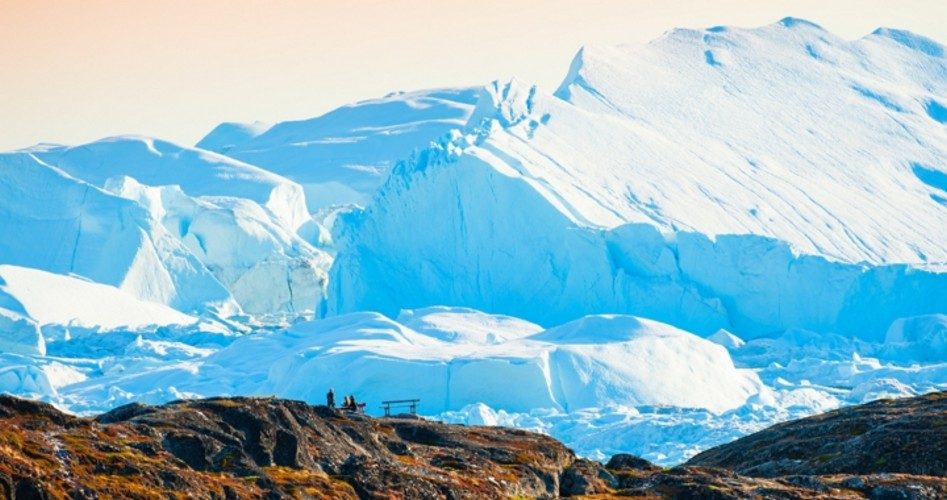
Over the past two decades, the Jakobshavn Glacier in Greenland had been melting at what climate alarmists might term an alarming rate. However, a new study published in Nature Geoscience has concluded that since 2016, the Jakobshavn Glacier is now growing again.
Using airborne altimetry and satellite imagery data, the study concludes that since 2016, the glacier has been advancing. The data used was from NASA’s Oceans Melting Greenland (OMG) mission. The study was conducted by NASA’s Jet Propulsion Laboratory (JPL) with contributions from Remote Sensing Solutions in Barnstable, Massachusetts, and the University of Utrecht in the Netherlands.
The study traces the glacier’s growth spurt to a naturally occuring cycle of cooler water in the North Atlantic more than 600 miles south of the glacier. Researchers posit that the cold water was set in motion due to an effect known as the North Atlantic Oscillation (NAO), which causes the Northern Atlantic to switch slowly between warm and cold every five to 20 years.
The water in Disko Bay, where the glacier meets the Atlantic, is now 3.6 degrees Fahrenheit cooler than it was just a few years ago, causing the Jakobshavn Glacier to grow. Water temperatures in the vicinity of the glacier are now colder than they’ve been since the mid-1980s.
And, boy, were the scientists surprised about it.
“At first, we didn’t believe it. We had pretty much assumed that Jakobshavn would just keep going on as it had over the last twenty years,” said Ala Khazendar, a research scientist at JPL and the lead author of the study.
Around 2012, Jakobshavn had been retreating at roughly 1.8 miles, and thinning at about 130 feet, annually. However, according to the study, it has been growing again at roughly those same rates since 2016.
As far as ice loss and its potential contribution to sea-level rise, the Jakobshavn glacier is one of the most important in the Northern Hemisphere.
“This was kind of a surprise. We kind of got used to a runaway system,” said ice and climate scientist Jason Box of the Geological Survey of Denmark and Greenland. “The good news is that it’s a reminder that it’s not necessarily going that fast. But it is going.”
Box was not a part of the study, but he called Jakobshavn “arguably the most important Greenland glacier because it discharges the most ice in the Northern Hemisphere. For all of Greenland, it is king.”
Another NASA scientist, who was not part of the project, lauded the OMG mission for its groundbreaking scientific potential. Tom Wagner, NASA Headquarters program scientist for the cryosphere, said, “The OMG mission deployed new technologies that allowed us to observe a natural experiment, much as we would do in a laboratory, where variations in ocean temperature were used to control the flow of a glacier. Their findings — especially about how quickly the ice responds — will be important to projecting sea level rise in both the near and distant future.”
But in 2019, where climate is concerned, there can never be good news. Any study must be spun to include impending disaster.
Scientists connected to the study were quick to point out that the glacier’s growth is only an “interruption” of the expected long-term glacial melt supposedly caused by anthropogenic (man-made) global warming.
“Jakobshavn is getting a temporary break from this climate pattern. But in the long run, the oceans are warming. And seeing the oceans have such a huge impact on the glaciers is bad news for Greenland’s ice sheet,” according to Josh Willis of JPL, the principal investigator of OMG.
In other words, the growing glacier is only evidence of a brief respite from the scourge of man-made global warming. Once the North Atlantic Oscillation changes back to warmer water, future glacial melts will be catastrophic.
“All this is an indicator of how sensitive glaciers are to ocean temperatures,” Khazendar explained, hinting that that’s not a good thing.
“In the long run, we’ll probably have to raise our predictions of sea level rise again,” said Willis.
Climate scientists cannot simply report on findings without linking them to future disaster. Any study, even one showing an obvious slowdown in global warming — a growing glacier — must be linked to catastrophic climate change. It’s another sure sign that the study of climatology is as much political as it is scientific.
Image: Olga_Gavrilova via iStock / Getty Images Plus




